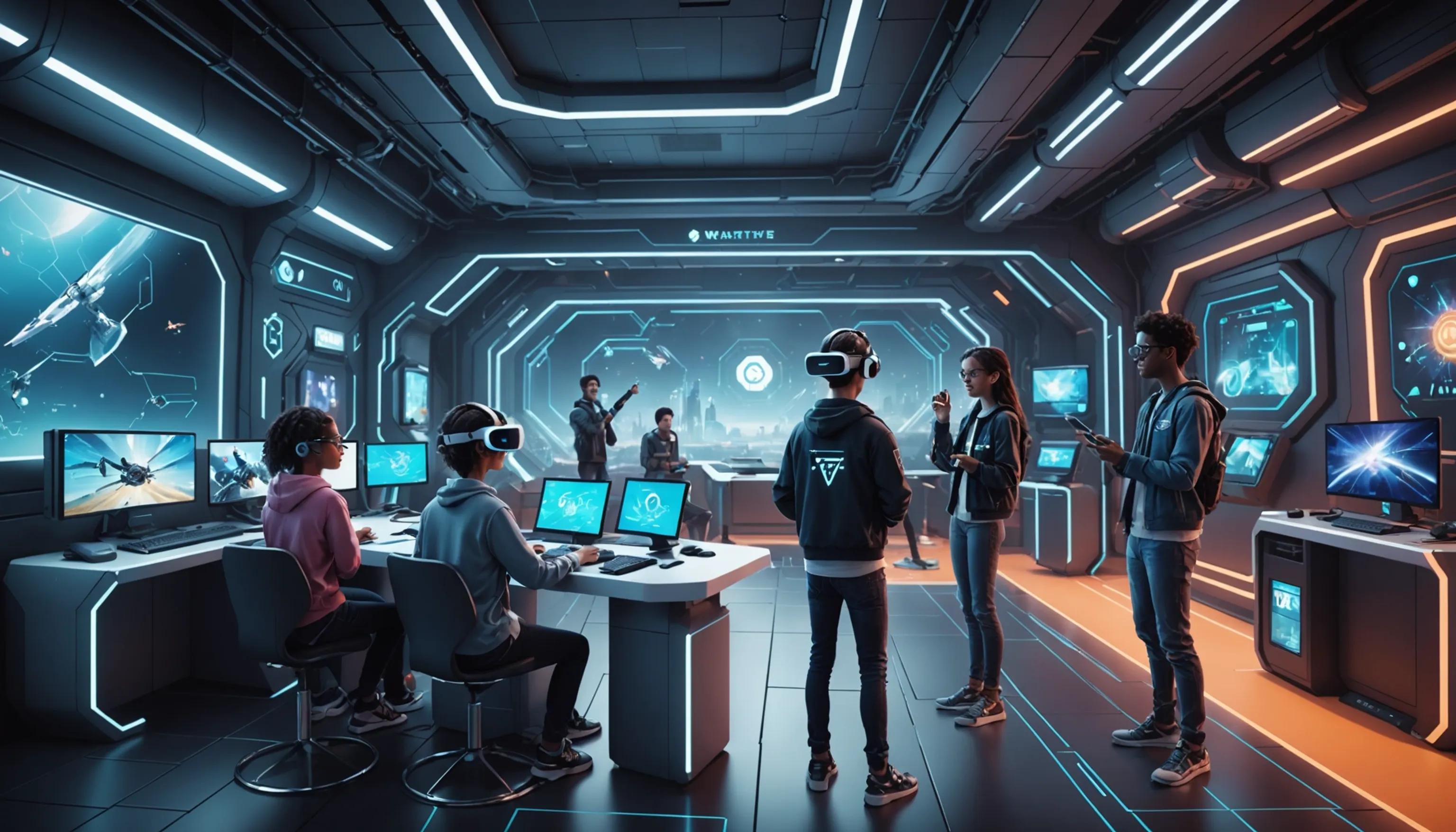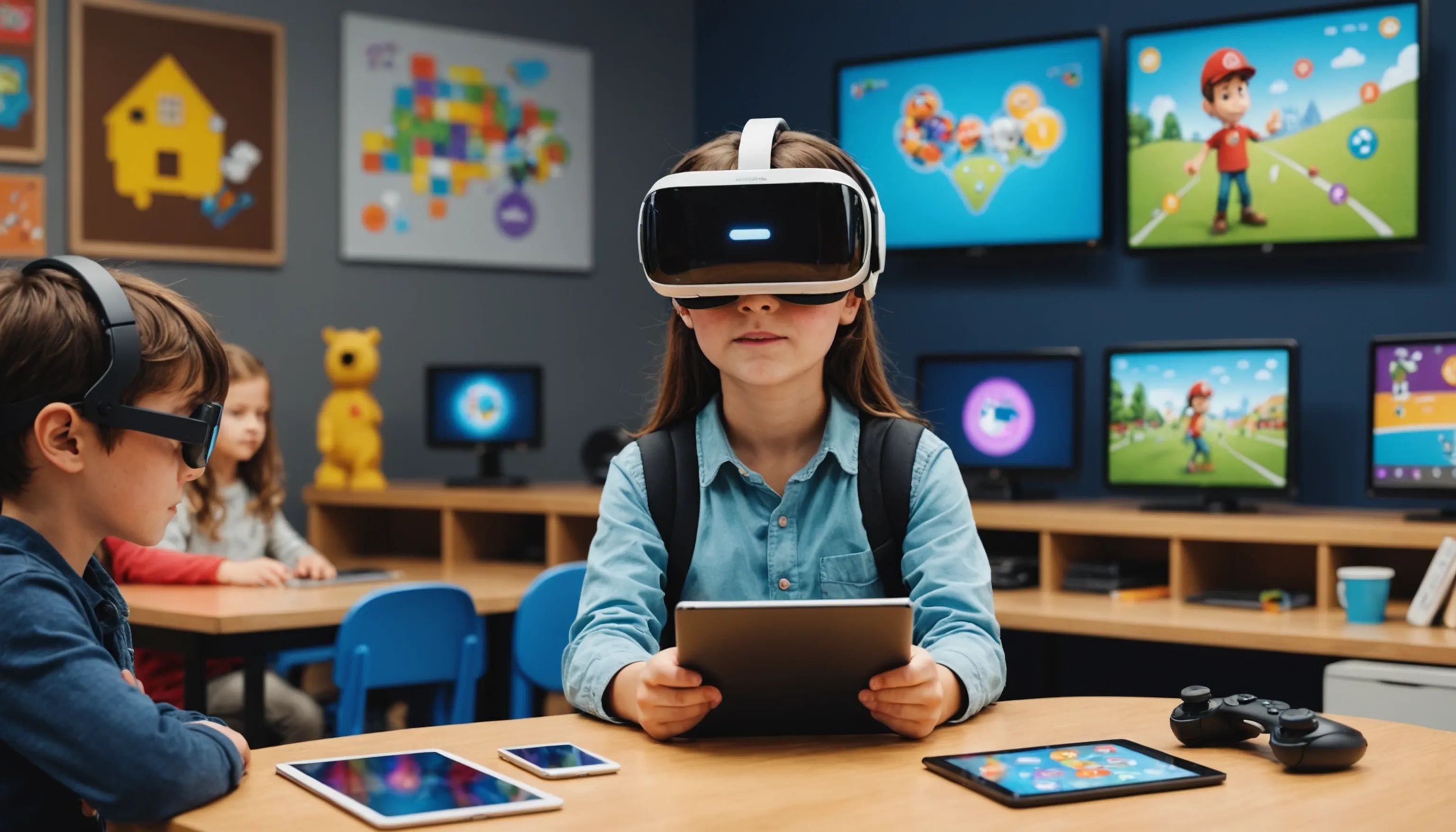Eventually, learning games will become great
 HvWHenry van Wagenberg
HvWHenry van Wagenberg
The Future of Learning Games
The future of learning games is promising, as they evolve to become more engaging and effective for teens. With advancements in technology, these games are likely to incorporate virtual reality and artificial intelligence, providing immersive experiences that cater to individual learning styles. As educational institutions increasingly recognize the value of gamification, we can expect a surge in innovative designs that encourage interactive learning.
Moreover, the collaboration between educators and game developers will lead to the creation of curricula that are both fun and educational, ensuring that learning is not only retained but also enjoyable.
Why Learning Games Are Important for Teens
Learning games play a crucial role in the education of teenagers, primarily because they cater to the unique learning preferences of this age group. Unlike traditional teaching methods, learning games provide an interactive platform that makes education more engaging and enjoyable. Here are some reasons why these games are important:
- Enhancing Motivation: Learning games transform educational content into exciting challenges, encouraging teens to participate actively. This increased motivation often leads to higher levels of achievement.
- Promoting Autonomy: Games allow students to take charge of their learning journey. They can progress at their own pace, making decisions that impact their gameplay, which fosters a sense of independence.
- Immediate Feedback: Unlike traditional assessments, learning games provide instant feedback. This helps teens understand their mistakes and learn from them right away, enhancing the learning process.
- Skill Development: Many learning games focus on critical skills such as problem-solving, time management, and decision-making. These skills are essential not only in academics but also in real-life situations.
Furthermore, learning games can bridge the gap between different subjects, making connections that help teens see the relevance of what they are learning. As education continues to evolve, the importance of learning games in engaging teens and facilitating effective learning will only grow.
How Learning Games Enhance Engagement
Learning games are a powerful tool for enhancing student engagement, particularly among teenagers. They transform traditional learning methods into interactive experiences that capture the attention of young learners. Here’s how learning games achieve this:
- Interactive Learning: Unlike passive learning methods, learning games require active participation. Teens must think critically, make decisions, and solve problems, which keeps them engaged and invested in the learning process.
- Gamification Elements: By incorporating elements such as points, levels, and rewards, learning games motivate students to reach goals. This gamification makes learning competitive and fun, encouraging teens to invest more time and effort into their education.
- Social Interaction: Many learning games are designed for multiplayer experiences, fostering teamwork and collaboration. This social aspect is crucial for teens, as they often thrive in environments that allow them to interact with their peers.
- Real-World Applications: Learning games often simulate real-world scenarios, allowing students to apply what they learn in practical situations. This relevance makes the content more relatable and increases engagement as teens see the value in their education.
Additionally, the use of technology in learning games, such as augmented reality and virtual reality, provides immersive experiences that further enhance engagement. As these technologies evolve, the potential for learning games to captivate teen learners will continue to grow, making education more dynamic and interactive.

The Role of Technology in Learning Games
The role of technology in learning games is pivotal, as it not only enhances the gameplay experience but also transforms educational methodologies. With the rapid advancement of technology, learning games have evolved to become more interactive, immersive, and effective in teaching essential concepts to teens.
- Interactive Platforms: Technology allows for the creation of interactive platforms where learners can engage with content in a dynamic way. Features such as touch screens, motion sensors, and voice recognition make the learning experience more engaging and tailored to individual preferences.
- Gamification Techniques: Incorporating technology facilitates gamification elements—like points, badges, and leaderboards—that motivate students to participate and excel. These elements create a competitive spirit that encourages teens to improve their skills while enjoying the learning process.
- Adaptive Learning: Advanced learning games utilize algorithms to adapt content based on individual performance. This personalized approach ensures that each teen can progress at their own pace, receiving the right level of challenge to keep them engaged.
- Access to Resources: Technology enables easy access to a wealth of educational resources, including tutorials, forums, and supplementary materials. This accessibility supports diverse learning styles and encourages exploration beyond the game.
Additionally, technologies like virtual reality (VR) and augmented reality (AR) create immersive environments that enhance understanding by allowing students to experience concepts in a simulated context. As technology continues to advance, its role in learning games will further expand, making education more engaging and effective for teenagers.
Benefits of Great Learning Games
Great learning games offer numerous benefits that significantly enhance the educational experience for teenagers. First, they improve knowledge retention by making learning enjoyable and interactive, which keeps students engaged. Second, they foster critical thinking skills as players navigate challenges and make decisions. Additionally, learning games promote collaboration and teamwork, allowing teens to work together to achieve common goals. They also provide immediate feedback, helping students understand their progress and areas for improvement. Ultimately, great learning games create a fun and effective learning environment that prepares teens for future academic and real-world challenges.
Improved Retention of Knowledge
Improved retention of knowledge is one of the most significant benefits of incorporating learning games into education, especially for teenagers. Traditional learning methods often struggle to maintain student interest, leading to a lack of engagement and retention. In contrast, learning games create an interactive environment that captivates students and helps them absorb information more effectively.
- Active Participation: Learning games require active involvement from students, encouraging them to think critically and make decisions. This hands-on approach enhances understanding and retention, as students are more likely to remember information they have actively engaged with.
- Contextual Learning: Many learning games present information within a relatable context, allowing teens to see the practical application of what they are learning. When students can connect new knowledge to real-life scenarios, it becomes more memorable.
- Repetition and Practice: Games often include repetition in a fun format, allowing students to practice concepts multiple times without it feeling tedious. This reinforcement helps solidify knowledge and makes it easier to recall in the future.
- Instant Feedback: Learning games provide immediate feedback on performance, helping students identify their strengths and weaknesses. This feedback loop encourages self-reflection and reinforces learning, as students can adjust their strategies based on their performance.
In summary, the engaging nature of learning games not only makes education enjoyable but also leads to significantly improved retention of knowledge. By utilizing these tools, educators can create a more effective learning environment that better prepares teens for academic success.

Fostering Critical Thinking Skills
Fostering critical thinking skills is one of the standout advantages of utilizing learning games in education for teenagers. In today's fast-paced and complex world, the ability to analyze situations, make informed decisions, and solve problems is more important than ever. Learning games provide an ideal platform for developing these essential skills.
- Problem-Solving Challenges: Many learning games present players with a variety of challenges that require strategic thinking and problem-solving. As teens navigate these challenges, they learn to analyze situations, consider different perspectives, and devise effective solutions. This process encourages a deeper understanding of the material.
- Decision-Making Opportunities: Learning games often require players to make decisions that impact the game's outcome. This element encourages teens to weigh the pros and cons of their choices, enhancing their ability to think critically about the implications of their actions.
- Encouraging Creativity: Games frequently allow for creative solutions to problems, encouraging players to think outside the box. This creativity not only enhances engagement but also fosters innovative thinking that can be applied in real-world scenarios.
- Collaboration and Discussion: Many learning games involve teamwork, prompting players to discuss their strategies and solutions with peers. This collaborative environment helps teens articulate their thought processes and learn from others, further developing their critical thinking skills.
In conclusion, learning games serve as a powerful tool for fostering critical thinking skills in teenagers. By engaging them in meaningful problem-solving and decision-making experiences, these games prepare students for the challenges of the future.
Encouraging Collaboration and Teamwork
Encouraging collaboration and teamwork is a fundamental benefit of learning games, especially for teenagers. In an era where social skills are vital for success in both academic and professional environments, these games provide a unique platform for students to develop and enhance their ability to work effectively with others.
- Multiplayer Experiences: Many learning games are designed for multiple players, requiring teens to collaborate to achieve common goals. This setup fosters a sense of camaraderie and encourages players to communicate and strategize together, essential components of successful teamwork.
- Role Assignment: Games often allow players to take on specific roles, each contributing unique skills to the team. This role assignment helps students recognize the value of diverse talents and perspectives, teaching them to appreciate the contributions of their peers.
- Conflict Resolution: Working in teams can sometimes lead to disagreements. Learning games provide a safe environment for teens to practice conflict resolution skills, helping them navigate challenges and find compromises. This experience is invaluable in preparing them for real-life situations where collaboration is necessary.
- Shared Success and Accountability: In learning games, the success of the team often depends on each member's participation and effort. This shared responsibility fosters a sense of accountability, motivating teens to contribute their best efforts and support their teammates.
In summary, learning games are an effective way to encourage collaboration and teamwork among teenagers. By engaging in these interactive experiences, students build essential social skills that will benefit them throughout their lives.
Examples of Successful Learning Games
There are numerous successful learning games that have made a significant impact on education for teenagers. Here are a few notable examples:
- Kahoot!: This game-based learning platform allows teachers to create quizzes that students answer in real-time. It fosters competition and engagement, making learning fun.
- Minecraft: Education Edition: This popular building game encourages creativity and problem-solving. It offers lessons in subjects like math, science, and history through immersive gameplay.
- Prodigy Math: Prodigy turns math into an adventure game, where students solve math problems to progress through quests. This approach enhances math skills while keeping students engaged.
- Duolingo: As a language-learning app, Duolingo uses gamification to teach new languages through interactive exercises and challenges.
These examples illustrate how learning games can effectively engage teens while enhancing their educational experience.
Popular Learning Games for Teens
Several popular learning games have gained traction among teenagers, effectively combining education with entertainment. These games engage students while enhancing their knowledge and skills across various subjects.
- Kahoot!: This interactive quiz platform has become a classroom favorite. Teachers create fun quizzes that students can answer in real-time using their devices. The competitive aspect, along with visually engaging formats, keeps teens motivated and eager to participate.
- Minecraft: Education Edition: This version of the beloved building game allows students to explore concepts in math, science, and history through creative projects. Its open-world format encourages collaboration and critical thinking, making learning immersive and hands-on.
- Quizlet: Known for its flashcard-based learning, Quizlet allows teens to study various subjects through interactive games and quizzes. It caters to different learning styles and helps reinforce key concepts.
- Prodigy Math: This game transforms math practice into an adventure. Players solve math problems to progress through quests, making learning enjoyable and tailored to individual skill levels.
- Duolingo: A leading app for language learning, Duolingo gamifies the process with bite-sized lessons, rewards, and challenges, making it engaging for teens eager to learn new languages.
These popular learning games not only make education enjoyable but also equip teens with valuable skills for their academic and future careers.
Games That Promote STEM Learning
Games that promote STEM (Science, Technology, Engineering, and Mathematics) learning are essential for preparing teenagers for future careers in these critical fields. Here are some notable examples that effectively engage students while fostering essential STEM skills:
- Kerbal Space Program: In this space flight simulation game, players design and launch their own spacecraft. This hands-on approach teaches physics, engineering principles, and problem-solving as players experiment with different designs and strategies to achieve their missions.
- CodeCombat: This game introduces coding concepts through interactive gameplay. Players write code to control their characters, solving puzzles and completing challenges. CodeCombat not only teaches programming languages but also develops critical thinking skills.
- RoboZZle: A social puzzle game that teaches programming logic in a fun way. Players guide a robot through mazes using simple commands, learning the basics of algorithms and programming concepts without prior knowledge.
- LEGO Mindstorms: Combining physical LEGO building with programming, this platform allows teens to create robots and automate tasks. It encourages creativity, engineering skills, and teamwork as students collaborate on projects.
- Scratch: Developed by MIT, Scratch is a visual programming language that lets teens create their own interactive stories, games, and animations. It fosters creativity while teaching foundational programming skills.
These games make STEM learning engaging and accessible, equipping teens with the skills they need for success in an increasingly technology-driven world.
Games for Developing Soft Skills
Games designed to develop soft skills are increasingly popular among teenagers, as they focus on essential interpersonal abilities that are critical for personal and professional success. Here are several notable games that effectively promote the development of soft skills:
- Teamwork: Overcooked!: This cooperative cooking simulation game requires players to work together under pressure to prepare and serve meals. It emphasizes communication, collaboration, and time management, as players must coordinate their actions to succeed in increasingly chaotic kitchen environments.
- Communication: Among Us: In this multiplayer game, players work together to complete tasks while trying to identify the impostor among them. The game encourages discussions, critical questioning, and persuasive communication, helping teens develop their ability to convey ideas and listen to others.
- Adaptability: The Sims: This life simulation game allows players to create and manage characters in various scenarios. It promotes adaptability, as players must navigate different challenges and make decisions that impact their virtual lives, fostering resilience and flexibility.
- Problem-Solving: Portal 2: This puzzle-platform game challenges players to solve complex problems using physics-based mechanics. It enhances critical thinking and problem-solving skills, as players must analyze situations and devise creative solutions to progress.
- Leadership: SimCity: Players take on the role of a city planner, making decisions to grow and manage a city. This game develops leadership skills by requiring players to balance resources, address community needs, and respond to crises.
These games not only make learning enjoyable but also equip teens with vital soft skills that will benefit them in their future endeavors.
